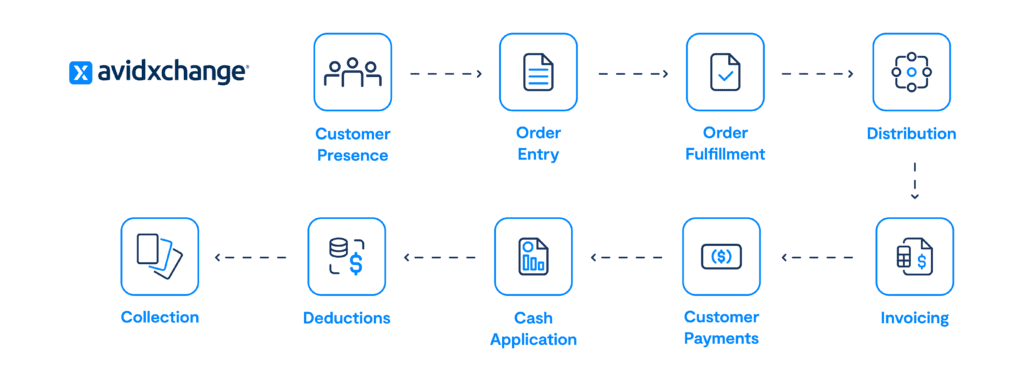In business, order to cash (O2C) encompasses the processes used to get paid from a customer order.
This can seem like a straightforward process, but anyone who has been involved in sales at a large company knows that the operation is not so simple. In this blog we provide an overview of the order to cash cycle and fresh ideas about how to cut down the process time.
Order to cash process flow and cycle
The order to cash process is made up of nine small processes. Each process is vital to business operations:

- Customer presence
- Order entry
- Order fulfillment
- Distribution
- Invoicing
- Customer payments
- Cash application
- Deductions
- Collection
Some computer systems, like an enterprise resource planning system (ERP), connect each of the order to cash processes. If a business sets up its sales systems efficiently, much of the order to cash process flow can take place without human interaction.
For digital products, like accounts payable automation, the entire process can take place with no human input at all outside of the customer entering order and payment information.
Order to cash process highlights
The order to cash process can be lumped into four major processes: order entry, order fulfillment, billing, and payment. The order of these processes may change depending on the industry, but the overall process works similarly for each business.
The order entry process may require manual intervention from a sales representative or an order entered by a customer directly. A consistent, high quality order entry system can prevent many problems later in the process, so it is important that this process is thoughtfully built to ensure efficiency and accuracy.
Order fulfillment varies most widely across industries. Construction, manufacturing, real estate and technology companies all operate very differently. Each industry has its own best practices for order fulfillment. Whenever possible, invoicing and accepting payment before delivery is ideal. This can dramatically shorten the order to cash process time.
Billing takes place automatically when the order is entered. However, most business people know that processes can be far from ideal. Connecting ordering, invoicing, and payment collection into one system will help manage the flow behind the scenes.
Payment can be made by issuing a check with check writing software, cash, credit card, debit card, or electronic funds transfer (EFT) in most cases. The options each business offers generally depends on the industry and customer needs.
It is important to remember that while sales bring business in the door, it is critical to effectively respond to each client’s unique needs in a timely manner. It is best to make it as easy as possible for customers to give you money.
Order to cash best practices
While every business has many options when approaching the order to cash cycle, some companies have emerged as clear industry leaders. By looking at what the best companies do, it is possible to identify the best order to cash practices to follow.
Standardize order to cash procedures company-wide
Whether a company has 10 employees or 10 thousand, consistency and standardization can help increase productivity and decrease order to cash process cycle time. Cutting even a day or two off of the order to cash cycle can help companies put more money in the bank, operate without financial worry, and help the company earn more through short-term cash investments.
Integrate all order to cash systems
Many large enterprises, particularly those that have grown through acquisition, often have dozens of independent computer systems. Integrating those systems creates efficiency that can shorten the order to cash cycle by automatically sending data into the next step. Fully integrating order, fulfillment, billing, and payment processing systems eliminates the possibility of human error and, depending on the industry and the company, can cut days or weeks off of the order to cash process. Finance and accounting professionals may need to push IT departments on this, but automating this process so can considerably improve processing times and cut costs.
Empowered staff to handle order to cash exceptions
Even the best-engineered and integrated processes may have an occasional exception. Some customers or sales staff do not enter an order right, a short system downtime causes some orders to fall out of the process, or one of dozens of other potential problems can arise. It is important to have well-trained staff standing by and ensure those employees are empowered to resolve the issue quickly and independently.
Constant monitoring and periodic evaluations of order to cash procedures
The ERP system behind corporate order to cash systems should be configured to send an automated alert any time an exception takes place. Requiring a human to review and intervene creates a situation ripe for failure. In addition to automated alerts, managers should use a scorecard or dashboard to review key metrics on a monthly or quarterly basis to identify and remove bottlenecks from the process. Setting high but realistic goals encourages the support team to take all possible steps for efficiency and success.
Remove friction with order to cash process improvements
Every business has opportunities to improve processes and procedures over time. Sometimes improvements can be iterated by internal teams, but oftentimes businesses look to outside consultants and vendors to better manage the order to cash cycle.
Order to cash software may look expensive, but well integrated tools can easily make up the cost. Improved margins and lower operating costs are always possible. If a process improvement allows reducing headcount by two or three employees, that can easily be worth $120,000 to $240,000 per year. Human resources are expensive and computers are almost always more efficient at order to cash processes.
Think about your experience each time you visit a restaurant. Even if you can quickly make your order and get your food in a hurry, if the server is slow to drop off your check or run your credit card, it can be frustrating. By optimizing the order to cash process flow, businesses can remove that frustration from its customers.
Every time managers and employees interact with any system in the order to cash cycle, they should be looking for opportunities to improve. Even a small improvement is worthwhile. It all adds up to better employee operations, shorter order to cash cycles, and most importantly, superior customer experiences.
Importance of the order to cash flow
While many companies look at order to cash improvements as a cost-cutting measure and a method to improve efficiency, do not underestimate the power it has to help a business grow. Bayer North America CEO Gregory Babe once shared a transformative plan to improve his business across the board. “Yes, we would need to spend money, which seemed contradictory,” he said. “But that money would help us grow the business while we significantly reduced costs in many areas.” This is the best mindset to have when evaluating the order to cash process.
Cash flow issues have put countless businesses in precarious positions; many well-run companies could face a cash crunch or even bankruptcy if orders are not quickly paid. By prioritizing and refining the order to pay system, you are setting your company up for long-term success.



